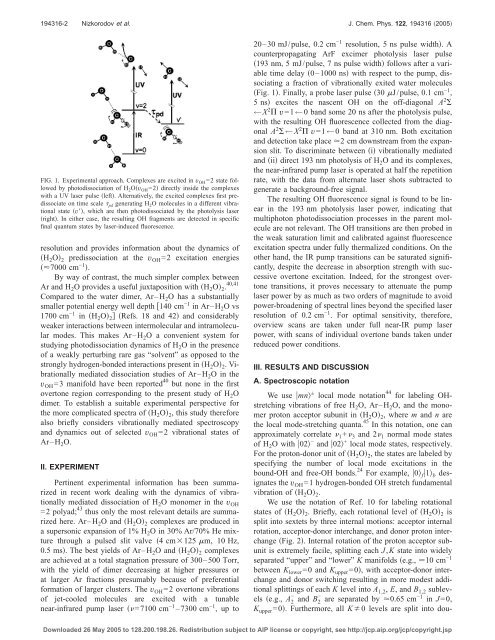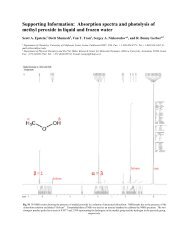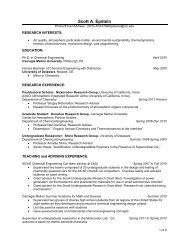Overtone spectroscopy of H2O clusters in the vOH - UCI Aerosol ...
Overtone spectroscopy of H2O clusters in the vOH - UCI Aerosol ...
Overtone spectroscopy of H2O clusters in the vOH - UCI Aerosol ...
- No tags were found...
You also want an ePaper? Increase the reach of your titles
YUMPU automatically turns print PDFs into web optimized ePapers that Google loves.
194316-2 Nizkorodov et al. J. Chem. Phys. 122, 194316 2005FIG. 1. Experimental approach. Complexes are excited <strong>in</strong> v OH =2 state followedby photodissociation <strong>of</strong> H 2 Ov OH =2 directly <strong>in</strong>side <strong>the</strong> complexeswith a UV laser pulse left. Alternatively, <strong>the</strong> excited complexes first predissociateon time scale pd generat<strong>in</strong>g H 2 O molecules <strong>in</strong> a different vibrationalstate v, which are <strong>the</strong>n photodissociated by <strong>the</strong> photolysis laserright. In ei<strong>the</strong>r case, <strong>the</strong> result<strong>in</strong>g OH fragments are detected <strong>in</strong> specificf<strong>in</strong>al quantum states by laser-<strong>in</strong>duced fluorescence.resolution and provides <strong>in</strong>formation about <strong>the</strong> dynamics <strong>of</strong>H 2 O 2 predissociation at <strong>the</strong> v OH =2 excitation energies7000 cm −1 .By way <strong>of</strong> contrast, <strong>the</strong> much simpler complex betweenAr and H 2 O provides a useful juxtaposition with H 2 O 2 . 40,41Compared to <strong>the</strong> water dimer, Ar–H 2 O has a substantiallysmaller potential energy well depth 140 cm −1 <strong>in</strong> Ar–H 2 Ovs1700 cm −1 <strong>in</strong> H 2 O 2 Refs. 18 and 42 and considerablyweaker <strong>in</strong>teractions between <strong>in</strong>termolecular and <strong>in</strong>tramolecularmodes. This makes Ar–H 2 O a convenient system forstudy<strong>in</strong>g photodissociation dynamics <strong>of</strong> H 2 O <strong>in</strong> <strong>the</strong> presence<strong>of</strong> a weakly perturb<strong>in</strong>g rare gas “solvent” as opposed to <strong>the</strong>strongly hydrogen-bonded <strong>in</strong>teractions present <strong>in</strong> H 2 O 2 .Vibrationallymediated dissociation studies <strong>of</strong> Ar–H 2 O <strong>in</strong> <strong>the</strong>v OH =3 manifold have been reported 40 but none <strong>in</strong> <strong>the</strong> firstovertone region correspond<strong>in</strong>g to <strong>the</strong> present study <strong>of</strong> H 2 Odimer. To establish a suitable experimental perspective for<strong>the</strong> more complicated spectra <strong>of</strong> H 2 O 2 , this study <strong>the</strong>reforealso briefly considers vibrationally mediated <strong>spectroscopy</strong>and dynamics out <strong>of</strong> selected v OH =2 vibrational states <strong>of</strong>Ar–H 2 O.II. EXPERIMENTPert<strong>in</strong>ent experimental <strong>in</strong>formation has been summarized<strong>in</strong> recent work deal<strong>in</strong>g with <strong>the</strong> dynamics <strong>of</strong> vibrationallymediated dissociation <strong>of</strong> H 2 O monomer <strong>in</strong> <strong>the</strong> v OH=2 polyad; 43 thus only <strong>the</strong> most relevant details are summarizedhere. Ar–H 2 O and H 2 O 2 complexes are produced <strong>in</strong>a supersonic expansion <strong>of</strong> 1% H 2 O <strong>in</strong> 30% Ar/70% He mixturethrough a pulsed slit valve 4 cm125 m, 10 Hz,0.5 ms. The best yields <strong>of</strong> Ar–H 2 O and H 2 O 2 complexesare achieved at a total stagnation pressure <strong>of</strong> 300–500 Torr,with <strong>the</strong> yield <strong>of</strong> dimer decreas<strong>in</strong>g at higher pressures orat larger Ar fractions presumably because <strong>of</strong> preferentialformation <strong>of</strong> larger <strong>clusters</strong>. The v OH =2 overtone vibrations<strong>of</strong> jet-cooled molecules are excited with a tunablenear-<strong>in</strong>frared pump laser =7100 cm −1 –7300 cm −1 ,upto20–30 mJ/pulse, 0.2 cm −1 resolution, 5 ns pulse width. Acounterpropagat<strong>in</strong>g ArF excimer photolysis laser pulse193 nm, 5 mJ/pulse, 7 ns pulse width follows after a variabletime delay 0–1000 ns with respect to <strong>the</strong> pump, dissociat<strong>in</strong>ga fraction <strong>of</strong> vibrationally exited water moleculesFig. 1. F<strong>in</strong>ally, a probe laser pulse 30 J/pulse, 0.1 cm −1 ,5ns excites <strong>the</strong> nascent OH on <strong>the</strong> <strong>of</strong>f-diagonal A 2 ←X 2 v=1←0 band some 20 ns after <strong>the</strong> photolysis pulse,with <strong>the</strong> result<strong>in</strong>g OH fluorescence collected from <strong>the</strong> diagonalA 2 ←X 2 v=1←0 band at 310 nm. Both excitationand detection take place 2 cm downstream from <strong>the</strong> expansionslit. To discrim<strong>in</strong>ate between i vibrationally mediatedand ii direct 193 nm photolysis <strong>of</strong> H 2 O and its complexes,<strong>the</strong> near-<strong>in</strong>frared pump laser is operated at half <strong>the</strong> repetitionrate, with <strong>the</strong> data from alternate laser shots subtracted togenerate a background-free signal.The result<strong>in</strong>g OH fluorescence signal is found to be l<strong>in</strong>ear<strong>in</strong> <strong>the</strong> 193 nm photolysis laser power, <strong>in</strong>dicat<strong>in</strong>g thatmultiphoton photodissociation processes <strong>in</strong> <strong>the</strong> parent moleculeare not relevant. The OH transitions are <strong>the</strong>n probed <strong>in</strong><strong>the</strong> weak saturation limit and calibrated aga<strong>in</strong>st fluorescenceexcitation spectra under fully <strong>the</strong>rmalized conditions. On <strong>the</strong>o<strong>the</strong>r hand, <strong>the</strong> IR pump transitions can be saturated significantly,despite <strong>the</strong> decrease <strong>in</strong> absorption strength with successiveovertone excitation. Indeed, for <strong>the</strong> strongest overtonetransitions, it proves necessary to attenuate <strong>the</strong> pumplaser power by as much as two orders <strong>of</strong> magnitude to avoidpower-broaden<strong>in</strong>g <strong>of</strong> spectral l<strong>in</strong>es beyond <strong>the</strong> specified laserresolution <strong>of</strong> 0.2 cm −1 . For optimal sensitivity, <strong>the</strong>refore,overview scans are taken under full near-IR pump laserpower, with scans <strong>of</strong> <strong>in</strong>dividual overtone bands taken underreduced power conditions.III. RESULTS AND DISCUSSIONA. Spectroscopic notationWe use mn ± local mode notation 44 for label<strong>in</strong>g OHstretch<strong>in</strong>gvibrations <strong>of</strong> free H 2 O, Ar–H 2 O, and <strong>the</strong> monomerproton acceptor subunit <strong>in</strong> H 2 O 2 , where m and n are<strong>the</strong> local mode-stretch<strong>in</strong>g quanta. 45 In this notation, one canapproximately correlate 1 + 3 and 2 1 normal mode states<strong>of</strong> H 2 O with 02 − and 02 + local mode states, respectively.For <strong>the</strong> proton-donor unit <strong>of</strong> H 2 O 2 , <strong>the</strong> states are labeled byspecify<strong>in</strong>g <strong>the</strong> number <strong>of</strong> local mode excitations <strong>in</strong> <strong>the</strong>bound-OH and free-OH bonds. 24 For example, 0 f 1 b designates<strong>the</strong> v OH =1 hydrogen-bonded OH stretch fundamentalvibration <strong>of</strong> H 2 O 2 .We use <strong>the</strong> notation <strong>of</strong> Ref. 10 for label<strong>in</strong>g rotationalstates <strong>of</strong> H 2 O 2 . Briefly, each rotational level <strong>of</strong> H 2 O 2 issplit <strong>in</strong>to sextets by three <strong>in</strong>ternal motions: acceptor <strong>in</strong>ternalrotation, acceptor-donor <strong>in</strong>terchange, and donor proton <strong>in</strong>terchangeFig. 2. Internal rotation <strong>of</strong> <strong>the</strong> proton acceptor subunitis extremely facile, splitt<strong>in</strong>g each J,K state <strong>in</strong>to widelyseparated “upper” and “lower” K manifolds e.g., 10 cm −1between K lower =0 and K upper =0, with acceptor-donor <strong>in</strong>terchangeand donor switch<strong>in</strong>g result<strong>in</strong>g <strong>in</strong> more modest additionalsplitt<strong>in</strong>gs <strong>of</strong> each K level <strong>in</strong>to A 1,2 , E, and B 1,2 sublevelse.g., A 2 − and B 2 − are separated by 0.65 cm −1 <strong>in</strong> J=0,K upper =0. Fur<strong>the</strong>rmore, all K0 levels are split <strong>in</strong>to dou-Downloaded 26 May 2005 to 128.200.198.26. Redistribution subject to AIP license or copyright, see http://jcp.aip.org/jcp/copyright.jsp





